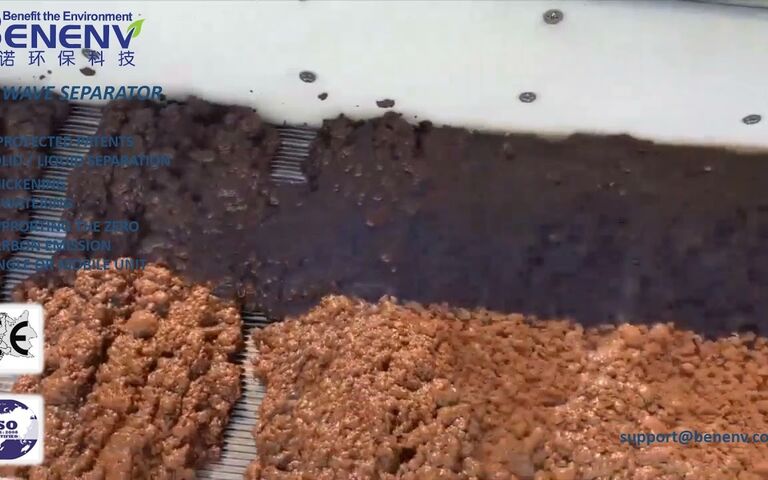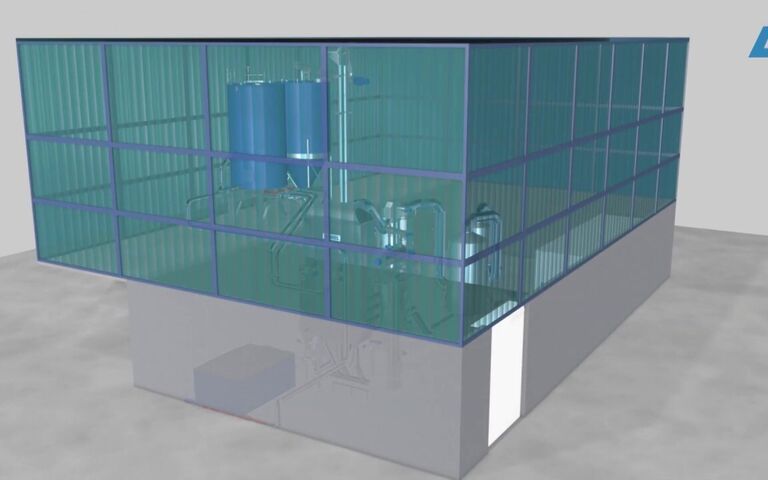Sludge conditioning – ten research papers

Diversity in the study of sludge conditioning
Our list is presented in reverse chronological order without preference. It was compiled by Simon Judd in October 2020, and may be updated in future as new papers are published.
This selection of abstracts taken from the SCOPUS database concerns the conditioning of sludge to improve its dewaterability and/or treatability.
A review of the research outputs in this area published since the start of 2019 show a remarkably eclectic range of options for enhancing sludge treatment. The selection below includes:
- ultrasonic treatment, combined with both regular conditioning chemicals (coagulants and polymers) and with ozonation
- magnetically-enhanced chemical dosing
- peracetic acid dosing
- persulphate dosing combined with zero valent iron
- combined enzymic treatment with freeze-thawing
- the combination of ferrate with the product biochar from downstream hydrothermal treatment
- dosing with oxidative transition metals to both improve dewaterability and catalyse downstream pyrolysis, and
- the combination of Fenton’s reagent and drumstrick tree.
There are well over 500 papers which include 'sludge' and 'conditioning' in the title, so just for good measure our selection includes a recent review article as well.
- Selected research papers:
Abstract
Impact of ultrasonication and ozonation pre-treatment on the sewage sludge and ultrasonication–ozonation integrated with anaerobic anoxic oxic system were investigated. According to response surface methodology, the optimal conditions were determined for an ozone dosage of 0.14 g·O3/g·SS and an ultrasonic intensity of 1.61 W/mL, which corresponded to a maximum sludge reduction ratio of 68.1%. When the residence time of broken sludge was 30 min and the reflux ratio was 60%, the broken sludge returned to the anaerobic or anoxic zone had little effect on chemical oxygen demand and improved total phosphorus removal rate of the anaerobic anoxic oxic system effluent. The broken sludge was returned to the anoxic zone, the removal rate of total nitrogen in the effluent of the anaerobic anoxic oxic system could be increased by 13.2%. The broken sludge backflow improved the sedimentation performance of the anaerobic anoxic oxic system sludge, which had little to do with reflow methods. The broken sludge reflowed to the anaerobic zone reduced the sludge production of the anaerobic anoxic oxic system by 51.3%.
© 2020 Institution of Chemical EngineersFull Reference
Ren, H., Wang, Y., Wei, Z., Liu, P., & Wang, B. (2020). Excess sludge conditioning with ultrasound/ozone and its effect on the anaerobic anoxic oxic process in a municipal wastewater treatment plant. Process Safety and Environmental Protection, 140, 170-177.
Abstract
Sewage sludge (mainly composed of excessive bio-sludge) is an inevitable by-product of biological wastewater treatment process and contains various toxic substances, such as pathogens, heavy metals, and organic contaminants. The production of sewage sludge may cause serious pollution risks without appropriate disposals. As the essential step of sludge treatment, dewatering plays significant roles in minimizing the sludge volume, facilitating the transportation, increasing the calorific value and even reducing the leachate production in landfill sites. This paper presents a comprehensive review on the issues related to dewatering of sewage sludge.
Section 1 starts with the environmental implications of sludge dewatering. Section 2 deals with the concepts and challenges about differentiation of bound water fractions, and also reviews the recent progress of in-situ visualization of water occurrence states in bio-flocs. Section 3 discusses about how various physiochemical properties influence the sludge dewaterability, and the insufficiency in in-situ micro-characterization of sludge constituents is pointed out. Section 4 reviews the existing conditioning technologies for sludge dewaterability improvement, and the advantages/disadvantages of each technology in terms of applicable occasions, material consumption, energy consumption and environmental impacts are evaluated. The last section (Section 5) specifically analyzes the feasibility of integrating sludge dewatering and re-utilization, and raises attention to the potential environmental risks of dewatering conditioning.
Based on the above discussion, we propose that a unified theory for sludge dewaterability improvement remains to be established. Especially, how the molecular structures of sludge compositions affect the solid-water interface behavior requires to be deepened, which will further unravel the mechanism behind strong water-holding capacities of bio-flocs. Additionally, we believe that the key challenges for sludge dewatering is how to select the appropriate conditioning technique according to the physiochemical properties of target sludge. The reliable indicators for real-time control of conditioning operations are still deficient, e.g., dynamic dosage control of conditioning chemicals. Accordingly, the potential environmental risks of excessive conditioning chemicals should be taken into more consideration.
© 2020 Elsevier LtdFull Reference
Wu, B., Dai, X., & Chai, X. (2020). Critical review on dewatering of sewage sludge: Influential mechanism, conditioning technologies and implications to sludge re-utilizations. Water Research, 180, 115912.
Abstract
This study verified the possibility of sludge conditioning before dewatering using a combination of factors such as iron coagulant, polyelectrolyte, and the magnetic field generated by a solenoid. It was assumed that further conditioning with the magnetic field, leads to the formation of a rigid structure of sludge flocs by the destabilized and flocculated solid phase particles in the sludge (using the conditioning dual chemical method: PIX-polyelectrolyte). The resulting structure can increase the efficiency of sludge cake filtration by reducing sludge compressibility and maintaining the porosity necessary for the flow of removed water through the filter cake. The effects of the exposure of conditioned sludge (after the dual chemical method) to the magnetic field depended on two factors. The first factor was the direction of sludge flow through the magnetic field. This was a key factor in improving the efficiency of sludge conditioning using this method. The sludge flow through the solenoid in the direction opposite to the magnetic field had a strong effect on the particles. The second factor was the rate of sludge flow through the magnetic field. Better results were obtained for a flow rate of 1.0 L/min than for pumping sludge through a coil at a rate of 2.0 L/min. At a flow rate of 1.0 L/min, the exposure time of the sludge to the magnetic field was 6.6 s. Too high a flow rate may lead to the deterioration of filtration efficiency by adverse changes in the structure of sludge flocs. This may be due to the mechanical destruction of the flocs structure of sludge by a too turbulent flow.
© 2020 by the authorsFull Reference
Kamizela, T., Kowalczyk, M., & Zawieja, I. (2020). The use of chemical methods and magnetic field in conditioning and dewatering of digested sewage sludge. Water (Switzerland), 12(6), 1642.
Abstract
Peracetic acid (PAA) is an environmentally friendly disinfectant and oxidizer used in several water and wastewater treatment applications. In the present study, PAA was utilized for the conditioning of municipal wastewater sludge before thickening and dewatering. It was shown that PAA can effectively prevent odor formation (i.e., H2S and NH3) and provide hygienization (using E. coli and Salmonella as indicators). Phytotoxicity can be prevented by controlling the amount PAA-conditioned sludge that is mixed in the soil to be fertilized. The required PAA dose for hygienization was relatively high (480 mg 100% PAA perL sludge) but the results indicated that other sludge stabilization processes are not necessarily required. Therefore, the proposed process involving PAA could be feasible in cases where limited land area is available for sludge processing or quick conditioning of sludge is required.
© 2019 The authorsFull Reference
Luukkonen, T., Prokkola, H., & Pehkonen, S. O. (2020). Peracetic acid for conditioning of municipal wastewater sludge: Hygienization, odor control, and fertilizing properties. Waste Management, 102, 371-379.
Abstract
Dewatering is of paramount step in sludge management, and conditioning with coagulant is considered as the commonest way to improve the sludge dewaterability. Sludge disintegration process was examined through Ultrasound (US) to strip the water from the sludge flocs and accordingly four coagulants: aluminium sulphate (Alum), iron (III) chloride (FeCl3), cationic polyacrylamide (CPAM) and combined ferric chloride and lime (CC) with optimum dosages were employed to improve the sludge dewaterability in terms of capillary suction time (CST), specific resistance to filtration (SRF) and moisture content (MC). The ultrasonic sludge disintegration with 1 min exposure with an energy dosage of 700 kJ/kg TS realises the best sludge dewatering efficiency. In addition, the effects of CPAM and CC conditioning on sludge dewaterability were higher compared with two other conditioners. The combined US-CPAM and US-CC with optimum dosages 8 and 101 mg/kg DS significantly improved sludge dewaterability parameters (MC: 68.50%, SRF: 1.03 × 1010 m/kg and CST: 31.82 s) and (MC: 72%, SRF: 1.08 × 1010 m/kg and CST: 31.82 s) compared with when conditioning experiments were performed alone. Scanning electron microscopy (SEM) images showed that the combined US-CPAM and US-CC conditioning formed a more porous structure and low compressible sludge filter cake which are desired to sludge dewatering. Therefore, the ultrasonic-assisted conditioning with CPAM and combined coagulant (lime + Ferric chloride) could significantly improve the sludge dewaterability indices.
© 2020 Informa UK Limited, trading as Taylor & Francis GroupFull Reference
Barati Rashvanlou, R., Pasalari, H., Moserzadeh, A. A., & Farzadkia, M. (2020). A combined ultrasonic and chemical conditioning process for upgrading the sludge dewaterability. International Journal of Environmental Analytical Chemistry, in press.
Abstract
A great prospect of sewage sludge self-recycling as a conditioner supports the research. A synergetic conditioning effect and mechanism were reflected after the synergistic conditioning experiment, and the corresponding separated experiment of biochar, K2FeO4 or acid treatment on WAS. All of the biochar, K2FeO4 and acid treatment could reduce the water content of sludge cake. Biochar had good effect on WAS settleability, although the influence of the biochar dosage was weak. Similar to K2FeO4, acid treatment also could reinforce the disintegration degree effectively, but it deteriorated the filter property of WAS. In the situation of synergistic condition, owing to the strong oxidation of K2FeO4, most of the sludge flocs was disintegrated, thus the settleability and filter property of WAS were still bad, even the biochar worked as a skeleton builder. It is encouraging to find that, even without acid treatment, there is a great decline of water content of sludge cake in the situation of synergistic condition.
© 2019 Elsevier LtdFull Reference
Wu, J., Lu, T., Bi, J., Yuan, H., & Chen, Y. (2019). A novel sewage sludge biochar and ferrate synergetic conditioning for enhancing sludge dewaterability. Chemosphere, 237, 124339.
Abstract
Aerobic digestion followed by dewatering is a widely applied method for sludge stabilization and reduction in decentralized wastewater treatment plants. It is important to enhance the sludge dewaterability of the aerobically digested sludge due to its considerable impact on cost of sludge disposal and management. In this study, an innovative technique is developed for improving the dewaterability of aerobically digested sludge by combined conditioning with persulfate (PS) and zero valent iron (ZVI). The results demonstrated that the dewaterability of aerobically digested sludge could be significantly enhanced with the PS and ZVI dosage in the range of 0–0.5 g/gTS and 0–0.4 g/gTS, respectively. The highest improvement was achieved at 0.05 g ZVI/g TS with 0.1 g PS/g TS, and the capillary suction time was reduced by ∼80%. The extracellular polymeric substances (EPS) characterization revealed that the combined PS-ZVI treatment could largely reduce proteins, polysaccharides and humic acids-like compounds in the tightly bounded EPS of the aerobically digested sludge, leading to bound water releasing from sludge flocs. The recovery of the ZVI particles could reach around 45%–80% after the treatment, further proved the sustainability of the approach. The proposed PS-ZVI conditioning would not have significant impact on the final choice of sludge disposal and the mainstream wastewater treatment. However, plant-scale test are still required for better assessing the proposed technique.
© 2019 Elsevier LtdFull Reference
Ni, B. -., Yan, X., Sun, J., Chen, X., Peng, L., Wei, W., Wang D., Mao S., Dai X., & Wang, Q. (2019). Persulfate and zero valent iron combined conditioning as a sustainable technique for enhancing dewaterability of aerobically digested sludge. Chemosphere, 232, 45-53.
Abstract
The effects of lysozyme (LZM) and freeze-thaw conditioning, alone or in combination, on sludge dewatering performance were comparatively investigated. After the optimization of the dewatering conditions using response surface methodology (RSM), the co-conditioning exhibited obvious superiority to the separate conditioning in improving the dewaterability of municipal sludge, with the capillary suction time (CST) and the water content (W) of the dewatered sludge reduced to 12 ± 0.5 s and 52.0% ± 0.4% from 61.8 s and 73.0%, respectively. The co-conditioning appeared not only to destroy the structure of extracellular polymeric substance (EPS) and microbial cell wall by virtue of enzymatic conditioning, but it formed larger particles and compact sludge floc structure with the help of freeze-thaw conditioning. Additionally, the bound water content of sludge decreased by 47.5% after co-conditioning, consistent with the enhancement in sludge dewaterability. All the results showed that LZM in combination with freeze-thaw conditioning had a great potential in sludge reduction, providing more opportunity of resource utilization for the dewatered sludge.
© 2019 North Carolina State UniversityFull Reference
Lin, F., Li, J., Zhu, X., Yu, P., & Liu, M. (2019). Conditioning effect of lysozyme combined with freeze-thaw on the municipal sludge dewatering performance. BioResources, 14(3), 7375-7386.
Abstract
Sewage sludge, the major by-product during the primary treatment and subsequent biotreatment of wastewater, is increasingly generated around the world. KMnO4 and Fe(II) consists both oxidation properties of KMnO4 and flocculation ability by in-situ formed Fe(III) and is widely used in water treatment. In this study, KMnO4Fe(II) was used as chemical conditioners to synchronously improve sludge dewatering performance and catalyze the biomass pyrolysis of waste activated sludge for preparing multi-functional material to remedy arsenic containing groundwater. The results showed that the sludge dewaterability was significantly improved due to the moderate pre-oxidation of extracellular polymeric substances by KMnO4, and then the sludge particles were re-flocculated by Fe(III) generated from KMnO4Fe(II). The conditioned sludge cake was then utilized for preparing sludge-based carbon (Fe-Mn-SBC) which was systematically characterized. The surface area of Fe-Mn-SBC was characteristic of high surface area (100.08 m2/g) which had a great adsorption capacity on arsenic. Besides, Fe-Mn-SBC could effectively oxidize As(III) to As(V), and addition of low dose of H2O2 can further improve total arsenic removal due to catalytic peroxidation of Fe-Mn-SBC. Besides, it was found that the presence of humic acid could inhibit the hydroxy iron formation and compete for the active adsorption sites and then resulted in the decrease in arsenic removal, and the co-existing humic acid could also be removed by adsorption of Fe-Mn-SBC. This work proposed a novel sludge treatment process by combining enhanced sludge dewatering with catalytic pyrolysis for preparing multi-functional materials, and they are promising in treatment of water containing combined pollutants.
© 2019 Elsevier LtdFull Reference
Ai, J., Zhang, W., Chen, F., Liao, G., Li, D., Hua, X., Wang, D., & Ma, T. (2019). Catalytic pyrolysis coupling to enhanced dewatering of waste activated sludge using KMnO4 and Fe(II) conditioning for preparing multi-functional material to treat groundwater containing combined pollutants. Water Research, 158, 424-437.
Abstract
The specific resistance to filtration (SRF), sludge cake water content, bound water content, extracellular polymeric substances (EPS) content, particle size, and microstructure of the flocs were measured to evaluate the efficiency of the combined treatment of Moringa oleifera (MO) with Fenton for sludge dewaterability. Results showed that the water content of the sludge cake was reduced from 73.86 to 62% when the dosages of Fe2+, H2O2, and MO were 31.93, 22.87, and 800 mg/g TS, respectively.
The Fenton-Moringa conditioned sludge (FMCS) presented a better dewaterability than that derived from the solo application of MO or Fenton, with the SRF closely correlating with the EPS central liquor (CL-EPS; R2 = 0.62), the light bound EPS (LB-EPS; R2 = 0.55) and the tight bound EPS (TB-EPS; R2 = -0.83). Moreover, the protein content of LB-EPS and TB-EPS in conditioned sludge showed a strong positive correlation with SRF (R2 = -0.79 with LB-EPS and R2 = 0.91 with TB-EPS). The zeta potential further displayed a strong correlation with SRF (R2 = 0.83).
Under Fenton-Moringa conditioning, the particle size of the sludge did not show a significant correlation with SRF (R2 =-0.20); however, there was a significant correlation between the particle size and the zeta potential (R2 = 0.56). The observed particle size was larger than that of Fenton conditioned sludge, allowing a better settling of the sludge particles. Furthermore, the microstructure of the FMCS also showed a more porous structure. While Fenton reduces the water content in sludge by disintegrating flocs, MO increases the particle size, neutralizes and aggregates the EPS, hence improving sludge dewaterability and rendering Fenton-MO attractive for sludge treatment.
© 2018 Elsevier Ltd. All rights reservedFull Reference
Faye, M. C. A. S., Zhang, K. K., Peng, S., & Zhang, Y. (2019). Sludge dewaterability by dual conditioning using Fenton's reagent with moringa oleifera. Journal of Environmental Chemical Engineering, 7(1) 102838.

Professor Simon Judd has over 30 years’ post-doctorate experience in all aspects of water and wastewater treatment technology, both in academic and industrial R&D. He has (co-)authored six book titles and over 200 peer-reviewed publications in water and wastewater treatment.
In his capacity as director of Judd Water & Wastewater Consultants, Simon is co-owner of SludgeProcessing.com, as well as of our sister website The MBR Site. He was Professor in Membrane Technology at the Cranfield Water Science Institute at Cranfield University in the UK from 1992 until 2021. Simon was also a Research Chair at Qatar University in the Middle East for six years until September 2018.




